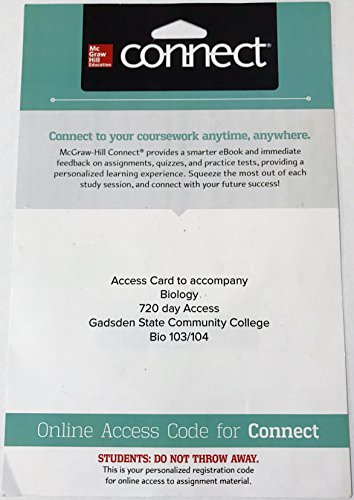
Connect Access Card Biology 720 Day Gadsden State Community College Bio 103/104
16th Edition
ISBN: 9781259691461
Author: Campbell
Publisher: MCGRAW-HILL HIGHER EDUCATION
expand_more
expand_more
format_list_bulleted
Textbook Question
Chapter 22, Problem 11A
Which of the following is increased in the mother during pregnancy?
metabolic rate- blood volume
- cardiac output
- All of these are correct
Expert Solution & Answer
Want to see the full answer?
Check out a sample textbook solution
Students have asked these similar questions
Pleiotropic genes are genes that (blank)
Cause a swapping of organs/structures, are the result of duplicated sets of chromosomes, never produce protein products, and have more than one purpose/function
A loss of function mutation in Pitx1 enhancers can cause (blank)
Removal of Pitx1 exons and growth of ectopic hindlimbs, growth of extra ectopic forelimbs, loss of forelimb specification and development, and loss of hindlimb specification and development
Hox1a most likely contributes to (blank) patterning in the developing embryo?
Ventral, posterior, limb or anterior
Chapter 22 Solutions
Connect Access Card Biology 720 Day Gadsden State Community College Bio 103/104
Ch. 22.1 - Identify the major structures of a sperm cell and...Ch. 22.1 - Describe the steps involved in fertilization.Ch. 22.1 - Describe the cellular, tissue, and organ stages of...Ch. 22.1 - Outline the steps of fertilization, beginning with...Ch. 22.1 - Describe two ways that an oocyte avoids...Ch. 22.1 - Compare and construct the cellular and tissue...Ch. 22.1 - Identify the organ system that are formed from...Ch. 22.2 - Explain how cellular differentiation and...Ch. 22.2 - Explain how cytoplasmic segregation and induction...Ch. 22.2 - Describe how morphogen genes, homeotic genes and...
Ch. 22.2 - Describe two process that are associated with...Ch. 22.2 - Define the term “morphogen”.Ch. 22.2 - Explain the function of the homeobox sequence in a...Ch. 22.3 - Identify the extraembryonic membranes and provide...Ch. 22.3 - Summarize in chronological order, the major events...Ch. 22.3 - Describe the flow of blood in a fetus and explain...Ch. 22.3 - Besides tobacco, alcohol, and illegal drugs what...Ch. 22.3 - Prob. 1CYPCh. 22.3 - Summarize the major events by month during fetal...Ch. 22.3 - Describe the path of blood flow in the fetus...Ch. 22.3 - Explain the function of the placenta.Ch. 22.4 - Describe changes that occur in Indian psychology...Ch. 22.4 - Outline the stages of birth.Ch. 22.4 - Summarize the advantages of breast-feedingCh. 22.4 - Describe the psychological changes that occur in a...Ch. 22.4 - Identify the stage of parturition in which the...Ch. 22.4 - Define colostrum, and least three advantage of...Ch. 22.5 - Describe the factors that contribute to aging.Ch. 22.5 - Discuss the effects of aging on various body...Ch. 22.5 - What is the rule of the hippocampus, and how does...Ch. 22.5 - How might anti-inflammatory drugs slow the...Ch. 22.5 - Explain how telomeres influence cellular aging.Ch. 22.5 - Summarize how that may contribute to aging.Ch. 22.5 - Summarize the diseases that are associated with...Ch. 22 - Prob. S5.4BYBCh. 22 - Figure 21.3 and 21.7 What are the difference...Ch. 22 - Section 21.2 and 21.3 Where does fertilization...Ch. 22 - Only one sperm enters an egg because Sperm have an...Ch. 22 - The fusion of a sperm and then it will initially...Ch. 22 - Which primary germ layer is not correctly matched...Ch. 22 - Which process is responsible for the shape and...Ch. 22 - The ability of one embryonic tissue to the...Ch. 22 - The Identity of each segment of a development...Ch. 22 - Prob. 7ACh. 22 - Prob. 8ACh. 22 - Prob. 9ACh. 22 - Prob. 10ACh. 22 - Which of the following is increased in the mother...Ch. 22 - Prob. 12ACh. 22 - Prob. 13ACh. 22 - Mitochondria contain their own genetic material....Ch. 22 - Prob. 2TCCh. 22 - 3. Variety of fertility tests are available for...
Knowledge Booster
Learn more about
Need a deep-dive on the concept behind this application? Look no further. Learn more about this topic, biology and related others by exploring similar questions and additional content below.Similar questions
- Select all of the following that can help establish Hox gene expression boundaries (things that affect Hox and not things that Hox affects). Retinoic acid, anterior/posterior axis, fibroblast growth factors, vagal neural crest, and enhancersarrow_forwardEctopic expression of Hox often results in (blank) phenotypes. (Blank) transformations are characterized by the replacement of one body part/structure with another. Hoxeotic, homealoneotic, joexotic, or homeoticarrow_forwardWhat's the difference when drawing omega-6 and omega-3?arrow_forward
- . Consider a base substitution mutation that occurred in a DNA sequence that resulted in a change in the encoded protein from the amino acid glutamic acid to aspartic acid. Normally the glutamic acid amino acid is located on the outside of the soluble protein but not near an active site. O-H¨ A. What type of mutation occurred? O-H B. What 2 types of chemical bonds are found in the R-groups of each amino acid? The R groups are shaded. CH2 CH2 CH2 H2N-C-COOH H2N-C-COOH 1 H Glutamic acid H Aspartic acid C. What 2 types of bonds could each R-group of each of these amino acids form with other molecules? D. Consider the chemical properties of the two amino acids and the location of the amino acid in the protein. Explain what effect this mutation will have on this protein's function and why.arrow_forwardengineered constructs that consist of hollow fibers are acting as synthetic capillaries, around which cells have been loaded. The cellular space around a single fiber can be modeled as if it were a Krogh tissue cylinder. Each fiber has an outside “capillary” radius of 100 µm and the “tissue” radius can be taken as 200 µm. The following values apply to the device:R0 = 20 µM/secaO2 = 1.35 µM/mmHgDO2,T = 1.67 x 10-5 cm2/secPO2,m = 4 x 10-3 cm/secInstead of blood inside the fibers, the oxygen transport and tissue consumption are being investigated by usingan aqueous solution saturated with pure oxygen. As a result, there is no mass transfer resistance in the synthetic“capillary”, only that due to the membrane itself. Rather than accounting for pO2 variations along the length ofthe fiber, use an average value in the “capillary” of 130 mmHg.Is the tissue fully oxygenated?arrow_forwardMolecular Biology Please help with question. thank you You are studying the expression of the lac operon. You have isolated mutants as described below. In the presence of glucose, explain/describe what would happen, for each mutant, to the expression of the lac operon when you add lactose AND what would happen when the bacteria has used up all of the lactose (if the mutant is able to use lactose).5. Mutations in the lac operator that strengthen the binding of the lac repressor 200 fold 6. Mutations in the promoter that prevent binding of RNA polymerase 7. Mutations in CRP/CAP protein that prevent binding of cAMP8. Mutations in sigma factor that prevent binding of sigma to core RNA polymerasearrow_forward
- Molecular Biology Please help and there is an attached image. Thank you. A bacteria has a gene whose protein/enzyme product is involved with the synthesis of a lipid necessary for the synthesis of the cell membrane. Expression of this gene requires the binding of a protein (called ACT) to a control sequence (called INC) next to the promoter. A. Is the expression/regulation of this gene an example of induction or repression?Please explain:B. Is this expression/regulation an example of positive or negative control?C. When the lipid is supplied in the media, the expression of the enzyme is turned off.Describe one likely mechanism for how this “turn off” is accomplished.arrow_forwardMolecular Biology Please help. Thank you. Discuss/define the following:(a) poly A polymerase (b) trans-splicing (c) operonarrow_forwardMolecular Biology Please help with question. Thank you in advance. Discuss, compare and contrast the structure of promoters inprokaryotes and eukaryotes.arrow_forward
- Molecular Biology Please help with question. Thank you You are studying the expression of the lac operon. You have isolated mutants as described below. In the absence of glucose, explain/describe what would happen, for each mutant, to the expression of the lac operon when you add lactose AND what would happen when the bacteria has used up all of the lactose (if the mutant is able to use lactose).1. Mutations in the lac repressor gene that would prevent the binding of lactose2. Mutations in the lac repressor gene that would prevent release of lactose once lactose hadbound3. Normally the lac repressor gene is located next to (a few hundred base pairs) and upstreamfrom the lac operon. Mutations in the lac repressor gene that move the lac repressor gene 100,000base pairs downstream.4. Mutations in the lac operator that would prevent binding of lac repressorarrow_forwardYou have returned to college to become a phylogeneticist. One of the first things you wish to do is determine how mammals, birds, and reptiles are related. Like any good scientist, you need to consider all available data objectively and without a preconceived “correct” answer. In pursuit of that, you should produce a phylogenetic tree based only on morphological features that show birds and mammals are more closely related. You will then produce a totally different tree, also using morphological features, that shows birds and reptiles are more closely related. Do not forget to include all three groups in both your trees. Based solely off the trees you produce, which relationship would you consider the more likely and why? Once you have answered that question, provide a brief summary of the “modern” understanding of the relationship between these three groups.arrow_forwardtrue or false, the reason geckos can walk on walls is hydrogen bonding between their foot pads and the moisture on the wall.arrow_forward
arrow_back_ios
SEE MORE QUESTIONS
arrow_forward_ios
Recommended textbooks for you
 Nutrition Through The Life CycleHealth & NutritionISBN:9781337919333Author:Brown, Judith E.Publisher:Cengage Learning,
Nutrition Through The Life CycleHealth & NutritionISBN:9781337919333Author:Brown, Judith E.Publisher:Cengage Learning, Human Biology (MindTap Course List)BiologyISBN:9781305112100Author:Cecie Starr, Beverly McMillanPublisher:Cengage Learning
Human Biology (MindTap Course List)BiologyISBN:9781305112100Author:Cecie Starr, Beverly McMillanPublisher:Cengage Learning

Nutrition Through The Life Cycle
Health & Nutrition
ISBN:9781337919333
Author:Brown, Judith E.
Publisher:Cengage Learning,



Human Biology (MindTap Course List)
Biology
ISBN:9781305112100
Author:Cecie Starr, Beverly McMillan
Publisher:Cengage Learning


The Cardiovascular System: An Overview; Author: Strong Medicine;https://www.youtube.com/watch?v=Wu18mpI_62s;License: Standard youtube license